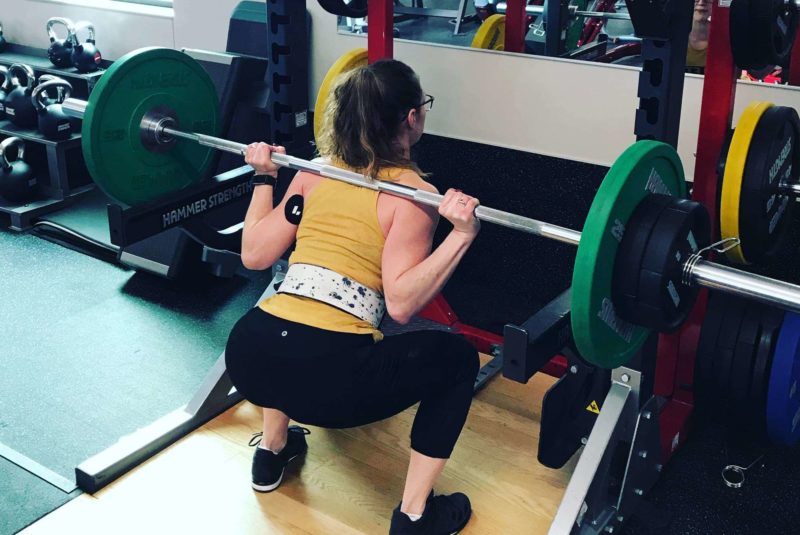“I was full keto for three years, and I became terrified of carbs,” says Allison Krook, a Levels user and keto influencer. “In my mind, I thought that if I ate carbs, I would get fat again.”
After three years of low-carb dieting and exercise, Allison dropped 95 pounds, shredding from a high of 219 pounds down to about 125. “The first two years I stayed below 20 net carbs, and stayed below 10 TOTAL carbs for about eight months of that,” reminisces Allison.
These days, after using continuous glucose monitoring and Levels, Allison is now including many of the “forbidden foods” that rigid keto diet practitioners tend to avoid: things like carrots, apples, pears, and more. She has been able to liberalize her keto diet by seeing in real-time that certain “keto-unfriendly” items actually do very little to raise her glucose, making them fair game for her and little risk of kicking her out of ketosis.
While the results of most hardcore diets are hard to dispute, the underlying psychological attachment or rejection of certain types of food that develop can be very rigid and limiting.
So, how would an individual that pushed through eight grueling months of a total of 10 carbs view something like an apple (~30g carbs) or even a carrot (~10g carbs)?
The answer is: with terror.
“I had full-blown carb-phobia because I felt that any carb I ate would have super negative effects on my health. Seriously, I would toss out every carrot from my salads,” Allison laughs.
Although Allison managed to hit her weight loss goals, she felt a lack of energy when it came to her muscle-building gym routines.
“I had gotten to this point where I lost all the weight I’d wanted to, and now I’m trying to build muscle,” says Allison. “Instead of carbs, I was taking in more pre-workout caffeine, and my energy levels were pretty erratic. I wanted a more natural way to fuel muscles.”
In her research to find dietary flexibility and more energy for her workouts, Allison found out about Levels.
“My goal with Levels was to see whether I’m metabolically flexible or not. Can I have these carbs? What do they actually do to my body? I found that carbs in moderation really don’t do a whole lot!”
After using Levels for just two months, Allison was able to make some adjustments to her rigid keto diet, and in doing so, fight off the carb phobia, one carrot at a time. By using continuous glucose monitoring to identify whether foods were impacting her glucose levels, she was able to identify many foods she could consume without a big impact on ketosis.
“The metabolic data is super interesting to me because it shows me how my body is responding to the carbs I eat,” says Allison. “I love the concept of metabolic flexibility. Since I started using Levels, I’ve remained at around 30 total carbs daily, and I use them to get more energy in my workouts.”
Allison’s Journey to Metabolic Flexibility
Using Levels, Allison also found that it’s not just about individual foods; a lot of the glucose response has to do with how you pair foods together.
“It was so fun and interesting to see how my body reacted and how I could mitigate certain responses from foods I was afraid of,” comments Allison, explaining her enthusiasm about finally being able to eat an apple without stressing. “I loved the meal comparison feature.”
“One of the things I loved that came out in the app during my use was the ability to compare individual meals and responses,” says Allison. “I could tap on my score and a quick explanation would pop up to give me insight. I also loved being able to call in and ask questions if I needed anything.”
“I love having some control over my nutrition. After being keto for three years, I can finally start coming up with some unique and energy-packed recipes that are personally designed for me.”
The meal comparison feature is often a gem for any person seeking to understand how individual foods impact their unique metabolic reaction. For Allison, she notes how she used the feature to differentiate between glucose responses when she added in exercise close to a meal.
“I would use it to see how my body responded to the individual food, then later how exercise impacted the reaction, and how some simple food combinations can minimize my glycemic spikes,” says Allison. “For example, I’d eat an apple immediately before leg day and notice how my blood sugar only hit a peak of 110 mg/dL.”
Food Combination Reactions
“I tried mixing certain combinations to see my response,” says Allison. “I had a pear with cottage cheese. Pears are super sweet and I’d assume they would spike me, but with the cottage cheese, my glucose levels only raised a little, compared to eating the pear alone.”
Carbohydrate Sensitivity
Allison found that she was sensitive to certain carbs, such as bananas.
“Once I found out I could have some carbs, period, I wanted to make my experiments more specific,” says Allison. “Most carbs didn’t skyrocket me, but bananas did. I went from 96 mg/dL to 154 mg/dL from a single banana.”
Given this, she’s going to keep those off her keto diet, instead favoring fruit that has less of a glucose response for her.
Bananas caused a significantly higher spike compared to a large gala apple for Allison.
In an Instagram post, Allison describes the banana sensation: “One thing I noticed VERY QUICKLY was the SURGE of energy that I got from the sugars in the banana! BUT it was not an energy that is good for lifting, as it made me feel shaky🤪! By the end of the lift, the feeling had gone away (so definitely a quick hit) but that shows how ineffective fast sugars are for sustained performance [for me].”
More Mental Control over Nutrition
According to Allison, the data and analysis from Levels also helped her distinguish between mental cravings and physical needs for food. When people feel hunger, they may sometimes think it’s because of low blood sugar. However, when they see the data indicate that their glucose levels are fine, it can be reassuring evidence that the hunger may be more mental.
“Fasting often becomes a mental versus natural physical hunger,” says Allison. “By looking at where my blood sugar is at, it helps me understand whether I’m most likely craving something or if I’m genuinely hungry.”
Final Thoughts: Empowerment Through Data
Keto and carbs are often a forbidden pairing, and to maintain ketogenesis, many individuals followed strict regimens of foods that are specifically “keto-friendly.”
Sticking to this list can help ensure that glucose stays low and healthy, but it can also be restrictive and limiting. With emerging continuous glucose monitoring technology paired with software insights like Levels offers, individuals can now personalize their diets to maximize results by choosing foods that have minimal impact on glucose.
Since two people can respond very differently to the same carbohydrate (based on factors like genetics, body type, microbiome composition, insulin sensitivity, sleep quality, and more), glucose monitoring can clarify how a particular carb impacts you.
Carbohydrate quantity is not a foolproof metric of glucose rise in the bloodstream, so biofeedback can be extremely empowering.
For Allison, the glucose biofeedback generated by Levels allowed for inclusions of more foods, helped her understand how exercise can impact a food-related glucose elevation, and showed her how to combine foods in such a way to minimize glucose spikes.
“I really liked how easy Levels was to use; there was lots of functionality, tools, and explainers for the newbies or non-science people like me.”
Allison looks forward to using Levels to continue launching several new experiments to better explore her metabolic flexible ranges. She’s excited to learn how to continue receiving the mental and health benefits of a primarily keto diet while also making the most out of the valuable energy locked in carbs.
“I love having some control over my nutrition,” says Allison. “After being keto for three years, I can finally start coming up with some unique and energy-packed recipes that are personally designed for me.”
Today, Allison feels empowered over her health. Carbs no longer look like a scary step backward– they’re viewed as more of a valuable energy capsule that must be used responsibly. In two short months with Levels, Allison helped to completely restructure the foundation of her nutritional approach in favor of metabolic health.









